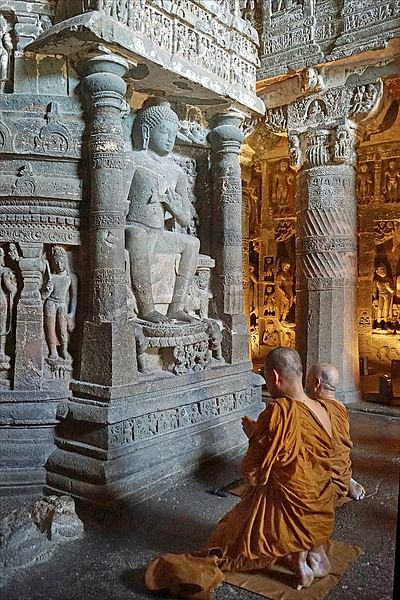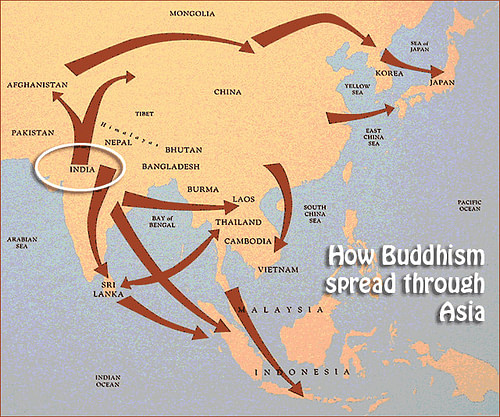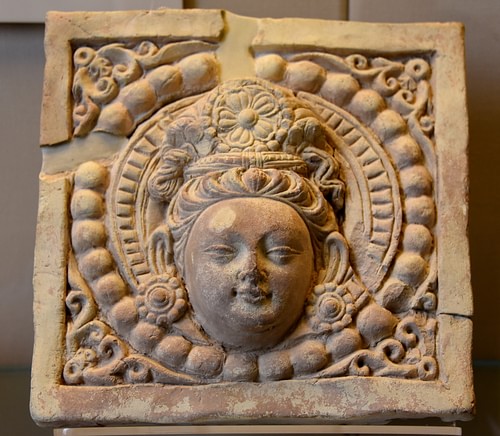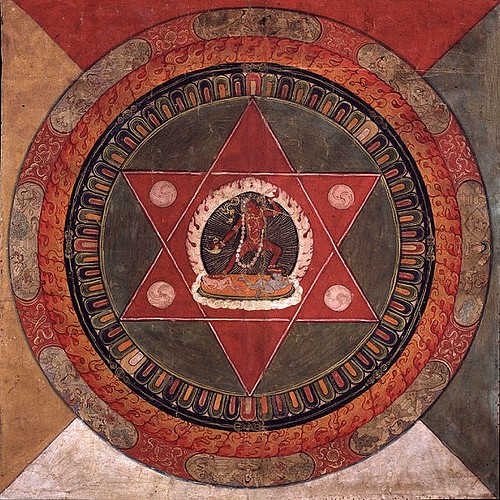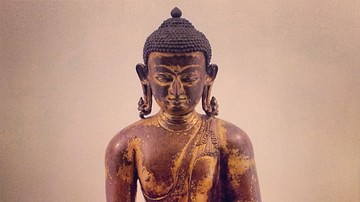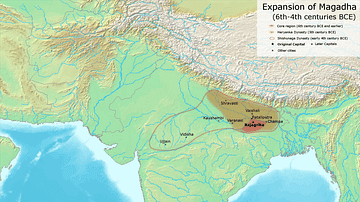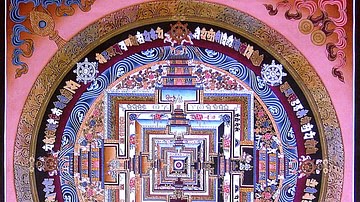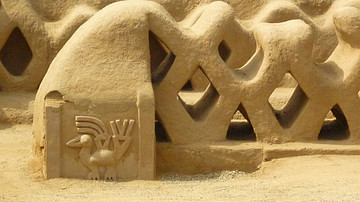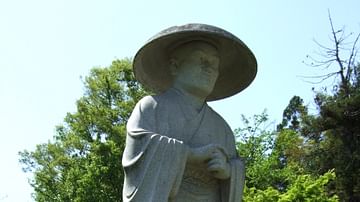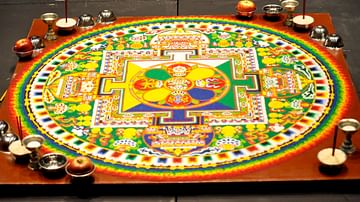The different Buddhist schools of thought, still operating in the present day, developed after the death of the Buddha (l. c. 563 - c. 483 BCE) in an effort to perpetuate his teachings and honor his example. Each of the schools claimed to represent Buddha's original vision and still do so in the modern era.
Although Buddha himself is said to have requested that, following his death, no leader was to be chosen to lead anything like a school, this was ignored and his disciples seem to have fairly quickly institutionalized Buddhist thought with rules, regulations, and a hierarchy.
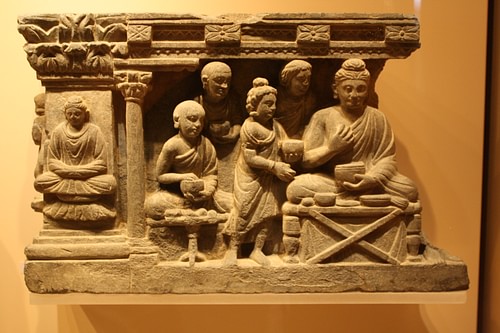
At first, there may have been a unified vision of what Buddha had taught but, in time, disagreements over what constituted the “true teaching” resulted in fragmentation and the establishment of three main schools:
- Theravada Buddhism (The School of the Elders)
- Mahayana Buddhism (The Great Vehicle)
- Vajrayana Buddhism (The Way of the Diamond)
Theravada Buddhism claims to be the oldest school and to maintain Buddha's original vision and teachings. Mahayana Buddhism is said to have split off from Theravada in the belief that it was too self-centered and had lost the true vision; this school also claims it holds to the Buddha's original teaching. Actually, however, the two schools may have been established around the same time, just with different focus, and probably emerged from two earlier schools: the Sthaviravada (possible precursor to Theravada) and the Mahasanghika (also given as Mahasamghika, considered by some the earlier Mahayana). The connection between these earlier schools and the later ones, however, has been challenged. Vajrayana Buddhism developed, largely in Tibet, in response to what were perceived as too many rules in Mahayana Buddhism and emphasized living the Buddhist walk naturally without regard to ideas of what one was “supposed” to do and so it, too, claims to be the most authentic.
All three schools maintain a belief in the Four Noble Truths and Eightfold Path as preached by the Buddha but differ – sometimes significantly – in how they choose to follow that path. Objectively, none are considered any more legitimate than the others, nor are the many minor schools which have developed, although adherents of each believe otherwise while, at the same time, recognizing they are all part of Ekayana ("One Vehicle" or "One Path") in that all embrace Buddha's central vision and seek to promote harmony and compassion in the world.
Although Buddhism is often perceived by non-adherents as a uniform belief system, it is as varied as any other in practice but, theoretically at least, a modern-day secular Buddhist can participate in rituals with a religious Buddhist without concern or conflict and all work toward the same essential goals.
Buddha & Buddhism
According to the foundational account of Buddha's life, he was born Siddhartha Gautama, a Hindu prince, and his father, hoping to prevent him from following a spiritual path instead of succeeding him as king, kept him from any experiences which might have made him aware of suffering and death. The king's plan succeeded for 29 years until Siddhartha witnessed the famous Four Signs while out riding one day – an aged man, a sick man, a dead man, and a spiritual ascetic – and became aware of the reality of sickness, old age, and death.
He renounced his wealth and position and followed the example of the spiritual ascetic, eventually attaining enlightenment upon recognizing the inherent impermanence of all aspects of life and realizing how one could live without suffering. He developed the concept of the Four Noble Truths, which state that suffering in life is caused by attachment to the things of life, and the Eightfold Path, the spiritual discipline one should follow to achieve release from attachment and the pain of craving and loss. Scholar John M. Koller comments:
The Buddha's teaching of [the Four Noble Truths] was based on his insight into interdependent arising (pratitya samutpada) as the nature of existence. Interdependent arising means that everything is constantly changing, that nothing is permanent. It also means that all existence is selfless, that nothing exists separately, by itself. And beyond the impermanence and selflessness of existence, interdependent arising means that whatever arises or ceases does so dependent upon conditions. This is why understanding the conditions that give rise to [suffering] is crucial to the process of eliminating [suffering]. (64)
Buddha illustrated these conditions through the Wheel of Becoming which has in its hub the triad of ignorance, craving, and aversion, between the hub and rim the six types of suffering existence, and on the rim the conditions which give rise to duhkha (translated as “suffering”). Ignorance of the true nature of life encourages craving for those things one believes are desirable and aversion to things one fears and rejects. Caught on this wheel, the soul is blinded to the true nature of life and so condemns itself to samsara, the endless repetition of rebirth and death.
Spread & Fragmentation
Buddha preached his vision from the time of his enlightenment until his death at 80 years of age, at which point he requested that his disciples should not choose a leader but that each should lead themselves. He also requested that his remains be placed in a stupa at a crossroads. Neither of these requests was honored as his disciples fairly quickly organized themselves as a group with a leader and divided his remains among themselves, each choosing to place them in a stupa in a location of their choice.
Around 400 BCE, they held the First Council at which they established accepted Buddhist doctrine based on the Buddha's teachings and, in 383 BCE, they held a Second Council at which, according to the standard account of the meeting, the Sthaviravada school insisted on the observance of ten proscriptions in the monastic discipline which the majority rejected.
At this point, either the Sthaviravada school left the community (known as the sangha) or the majority distanced themselves from the Sthaviravada and called themselves Mahasanghika ("Great Congregation"). All the later schools then developed from this first schism.
These schools had to contend with the more well-established belief systems of Hinduism and Jainism and, in an effort to level the playing field, developed an illustrious foundation story for their founder and attributed to him a number of miracles. Still, Buddhism remained a small sect in India, one among many, until it was championed by the Mauryan king Ashoka the Great (r. 268-232 BCE) who embraced the faith and initiated its spread. He sent missionaries to other nations such as Sri Lanka, China, Korea, Thailand, and Buddhism was accepted in these places far more quickly than in its home country.
Doctrinal differences, however, led to further divisions within the community of adherents. As the belief system became more institutionalized, these differences became more significant. Different canons of scripture developed which were held by some as true while rejected by others and different practices arose in response to the scripture. For example, the Pali canon, which emerged from Sri Lanka, maintained that Buddha was a human being who, although endowed with great spiritual power, still attained enlightenment through his own efforts and, when he died, he was set free from samsara and achieved total liberation from human affairs.
As Buddhism spread, however, the founder was deified as a transcendent being who had always existed and would always exist. Buddha's death was still understood as his nirvana, a “blowing out” of all attachment and craving, but some adherents no longer saw this as simply an escape from samsara but an elevation to an eternally abiding state; freed from samsara, but still present in spirit. The Mahasanghika school held to this belief as well as many others (such as the claim that the Buddha had never existed physically, only as a kind of holy apparition) which stood in direct contrast to the Sthaviravada and, later, the Theravada schools. Although the central vision of the Buddha was retained by adherents, doctrinal differences like this one led to the establishment of the different schools of Buddhist thought.
Although there were actually many schisms before the establishment of Theravada, Mahayana, and Vajrayana (the Mahasanghika school alone produced three different sects by c. 283 BCE), the division of these schools from the original sangha is said to have been predicted by the Buddha himself in what is known as The Three Turnings. This concept is based on that of the Dharmachakra (wheel of eight spokes, a familiar Buddhist symbol) which represents the Eightfold Path, informed by dharma which, in Buddhism, is understood as “cosmic law”. The Dharmachakra has always been in motion and always will be but, as far as human recognition of it goes, it was set in motion when Buddha gave his first sermon, would then make the first turn with the establishment of Theravada Buddhism, a second with Mahayana, and a third with Vajrayana.
Theravada Buddhism
Theravada Buddhism is said to be the oldest form of the belief system, but this is challenged by modern scholars. Robert E. Buswell, Jr. and Donald S. Lopez, Jr. explain:
Despite the way in which scholars have portrayed the tradition, Theravada is neither synonymous with early Buddhism nor a more pristine form of the religion prior to the rise of the Mahayana. Such a claim suggests a state of sectarian inertia that belies the diversity over time of doctrine and practice within what comes to be called the Theravada tradition. (904)
Even so, many of those who self-identify as Theravada Buddhists do still make the claim that it is the oldest version of Buddhism and the closest to the founder's vision. It is known as the "Teaching of the Elders" which derives from the same name held by the earlier school of Sthaviravada, and this is sometimes interpreted to mean that its founders were those closest to the Buddha but, actually, the term was commonly used in India to denote any monastic sect, and this applies directly to Theravada.
Adherents focus on the Three Trainings (trisksa):
- Sila (moral conduct)
- Samadhi (meditation)
- Prajna (wisdom)
This discipline is observed as part of the Eightfold Path and is inspired by the central figure of the school, the sage Buddhaghosa (5th century CE) whose name means “Voice of the Buddha” for his ability to interpret and comment upon Buddhist doctrine. They hold the Pali canon to be the most authentic and focus on a monastic interpretation of the Buddhist path in which the individual seeks to become an arhat (saint) and has no obligation to teach others the way toward enlightenment. One may certainly do so if one chooses but, unlike Mahayana Buddhism, the goal is not to become a spiritual guide to others but to free one's self from samsara.
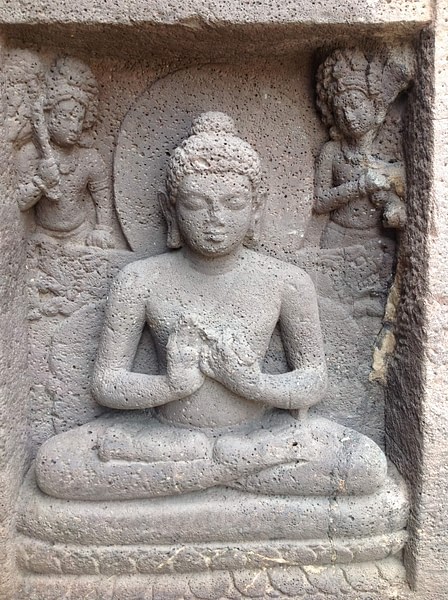
Theravada Buddhism is divided between a clergy of monks and a congregation of laypeople and it is understood that the monks are more spiritually advanced than the common folk. Women are considered inferior to men and are not thought capable of attaining enlightenment until they are reincarnated as a male. The Theravada school is sometimes referred to as Hinayana (“little vehicle”) by Mahayana Buddhists, but it should be noted that this is considered an insult by Theravada Buddhists in that it suggests their school is not as important as Mahayana.
Mahayana Buddhism
Mahayana Buddhists named themselves the “Great Vehicle” either because they felt they retained the true teachings and could carry the most people to enlightenment (as has been claimed) or because they developed from the early "Great Congregation" Mahasanghika school and wished to distance themselves from it, however slightly. It was founded 400 years after Buddha's death, probably inspired by the early Mahasanghika ideology, and was streamlined and codified by the sage Nagarjuna (c. 2nd century CE), the central figure of the school. It may have initially been a minor school before interacting with Mahasanghika or, according to some scholars, developed on its own without that school's influence but, either way, Mahayana is the most widespread and popular form of Buddhism in the world today, spreading from its initial acceptance in China, Korea, Mongolia, Japan, Sri Lanka, and Tibet to points all around the world.
The Mahayana school believes that all human beings possess a Buddha nature and can attain transcendent awareness, becoming a Bodhisattva (“essence of enlightenment”), who can then guide others on the same path. Adherents seek to attain the state of sunyata - the realization that all things are devoid of intrinsic existence, nature, and lasting meaning - a clearing of the mind that enables one to recognize the true nature of life. Having attained this higher state, just as Buddha did, one becomes a buddha. This transcendental state is similar to how gods and spirits were viewed by the Buddha himself - as existing but incapable of rendering any service to the individual – but, as a Bodhisattva, both women and men who have awakened are able to help others to help themselves.
As with Theravada and every other school of Buddhism, the focus is on the self – self-perfection and self-redemption – and no other can do the spiritual work which one needs to do to release one's self from suffering. Although Buddha is sometimes seen as a deified being by Mahayana Buddhists, the tenets do not encourage one to call on him for help. Following Buddha's own vision, a belief in a creator god who is attentive to one's prayers is discouraged because it attaches one to a power outside of one's self and sets one up for disappointment and frustration when prayers go unanswered.
This is not to say that no Mahayana Buddhists pray directly to the Buddha; the tradition of representing Buddha in statuary and art, of praying to these objects, and considering them holy - observed in Mahayana Buddhism - was initiated by the Mahasanghika school and is among the many compelling reasons to believe the younger school emerged from the older one.
Vajrayana Buddhism
Vajrayana Buddhism (“Diamond Vehicle”) is so-called because of its association of enlightenment with an unbreakable substance. Its name is also given as “Thunderbolt Vehicle”, especially in reference to Tantric or Zen Buddhism, in that enlightenment falls like a thunderbolt after one has put in the required effort at perfecting the self. It is often considered an offshoot of Mahayana Buddhism – is even referenced as a sect of that school – but actually borrows tenets from both Mahayana and Theravada Buddhism while adding an innovation of its own.
In both Theravada and Mahayana Buddhism, one decides to follow the path, accepts the Four Noble Truths and the Eightfold Path as legitimate, and commits to a spiritual discipline which will lead to enlightenment by renouncing unprofitable habits. In Vajrayana Buddhism, it is understood that one already has a Buddha nature – everyone does, just as Mahayana believes – but, in Vajrayana, one only has to realize this in order to fully awaken. An adherent, therefore, does not have to give up bad habits such as drinking alcohol or smoking right away in order to begin one's work on the path; one only has to commit to following the path and the desire to engage in unhealthy and damaging behaviors will steadily lose their allure. Instead of distancing one's self from desire, one steps toward and through it, shedding one's attachment as one proceeds in the discipline.
As with Mahayana Buddhism, the Vajrayana school focuses one on becoming a Bodhisattva who will then guide others. It was systematized by the sage Atisha (l. 982-1054 CE) in Tibet and so is sometimes referred to as Tibetan Buddhism. The Dalai Lama, often referenced as the spiritual leader of all Buddhists, is technically only the spiritual head of the Vajrayana School, and his views are most directly in line with this school of thought.
Other Schools
There are many other Buddhist schools which have developed from these three all around the world. In the West, the most popular of these is Zen Buddhism which traveled from China to Japan and was most fully developed there before arriving in the West. As Zen Masters are fond of saying, “What you call Zen is not Zen; What you do not call Zen is not Zen” meaning that the state of being one wishes to attain cannot be defined; it can only be experienced. One arrives at this state through deep meditation and mental concentration on koans – usually translated as “riddles” – which have no answer, such as the famous “What is the sound of one hand clapping?” – in order to clear the mind, rid the self of attachment, and attain the state of samadhi, a state of psychological and spiritual vision similar to sunyata. Students of Zen Buddhism frequently study with a master who might slap them, shout, or suddenly hit them with a stout stick in order to awaken them from the illusion of who they think they are and what they think they are doing. These sudden attacks without warning are engaged in, like the koans, to snap an adherent out of rational, linear thinking into a higher state of awareness.
Pure Land Buddhism is another which developed from Mahayana Buddhism and its goal is rebirth in a “pure land” of a Buddha Realm which exists on a higher plane. The belief comes from a story in the text known as the Infinite Life Sutra in which the Buddha tells a story of a past buddha named Amitabha who became a Bodhisattva and to whom were revealed the Buddha Realms available to the enlightened. Amitabha's efforts to save all sentient creatures from suffering resulted in the creation of the realm of Sukhavati, the greatest of all, in which one experiences complete bliss after leaving the body at death. Although Pure Land is its own school, some Mahayana Buddhists observe the same tenets.
An increasingly popular school in the West is Secular Buddhism which rejects all metaphysical aspects of the belief system to focus on self-improvement for its own sake. Secular Buddhism recognizes the Four Noble Truths and Eight-Fold Path but on purely practical and psychological levels. There are no saints, no Bodhisattvas, no Buddha Realms, no concept of reincarnation to be considered. One engages in the discipline as set down by the Buddha in order to become a better version of one's self and, when one dies, one no longer exists. There is no concept of a reward after death; one's efforts in being the best person one can be in life is considered its own reward.
Conclusion
It is actually impossible to tell which, if any, of these schools is closest to the original vision of the Buddha. Siddhartha Gautama, himself, wrote nothing down but instead – like many great spiritual figures throughout history whose followers then founded a religion in their name – lived his beliefs and tried to help others in their struggles. Since the earliest Buddhist texts were written centuries after the Buddha lived, and in an era when the events of a famous person's life were regularly embellished upon, it is unknown whether his so-called “biography” is accurate nor even the dates between which he is said to have lived.
However that may be, and whoever he was, the Buddha established a belief system which attracts over 500 million adherents in the present day and has, for centuries, offered people a path toward peace of mind and inspiration to help others. The Buddhist belief in the sanctity of all life – no matter which school one attaches one's self to – promotes care for other human beings, animals, and the earth in an effort to end suffering and offer transformative possibilities. In this respect, each school works toward goals that Buddha himself would approve of and differences in how those goals are reached are ultimately irrelevant.
